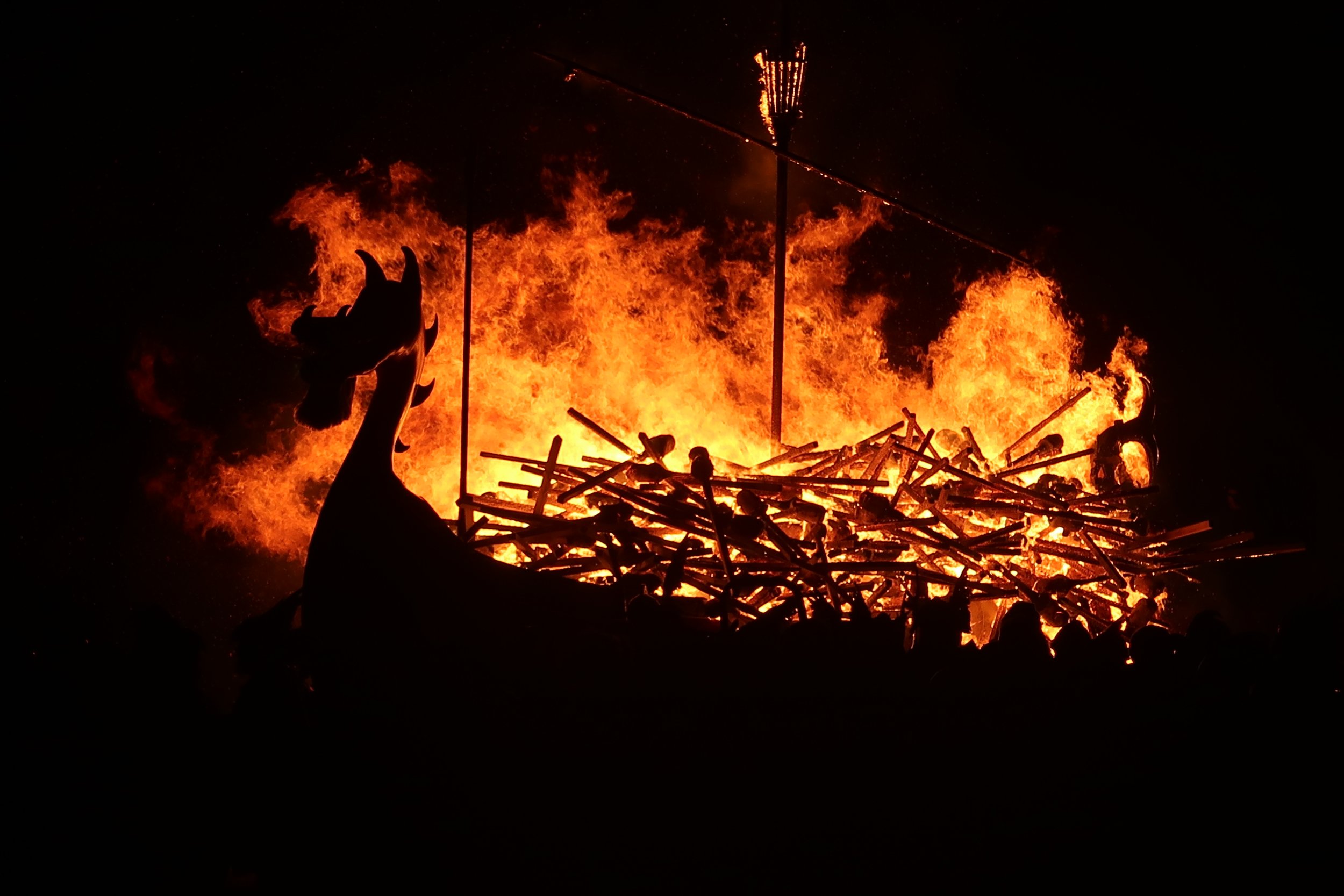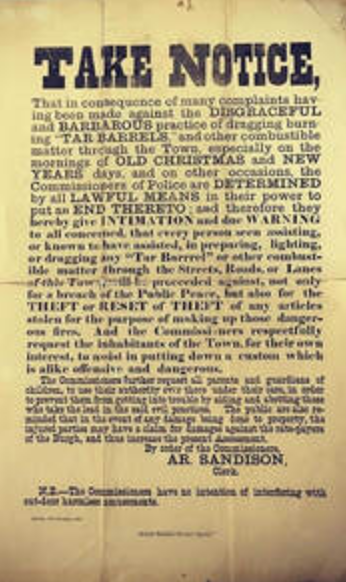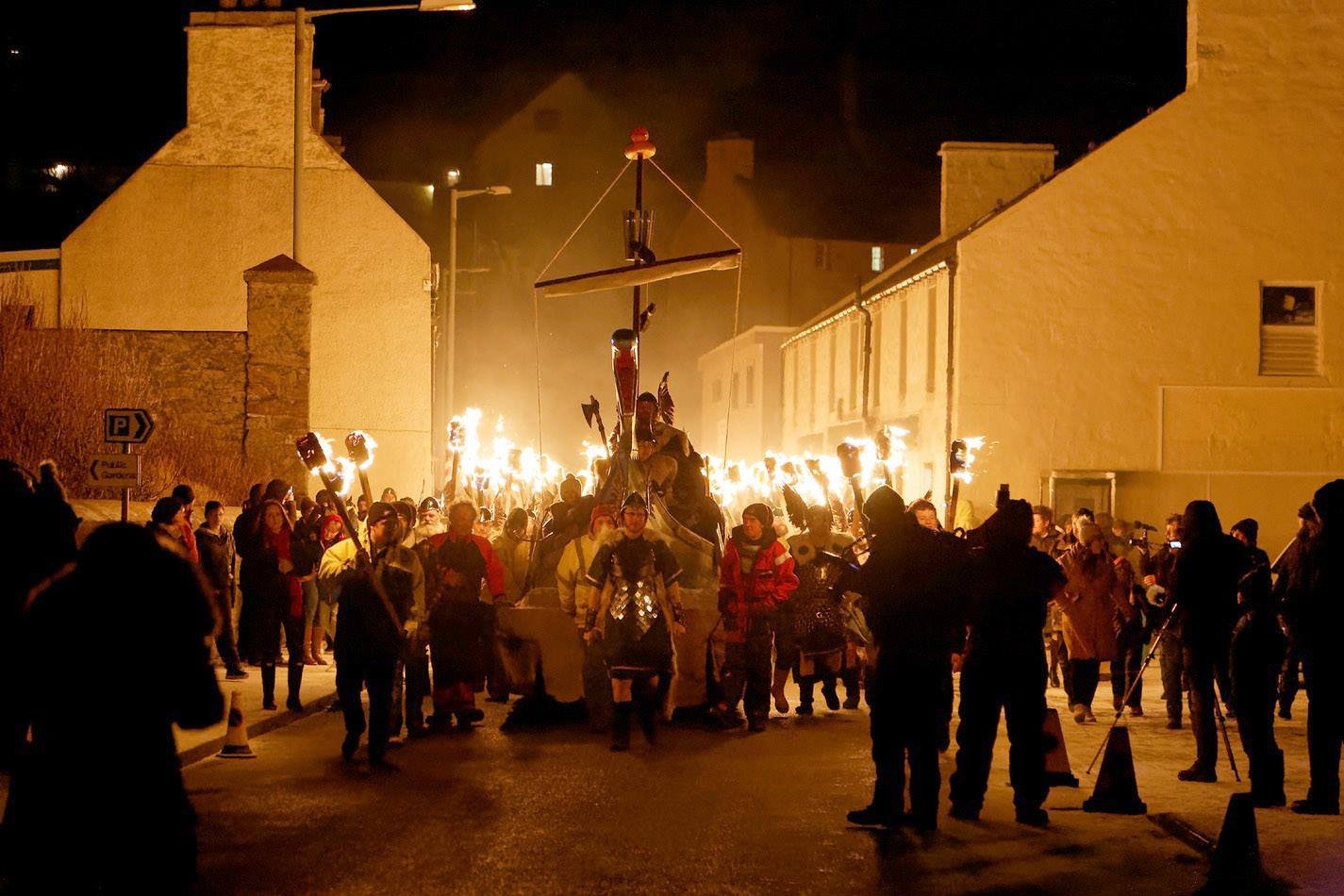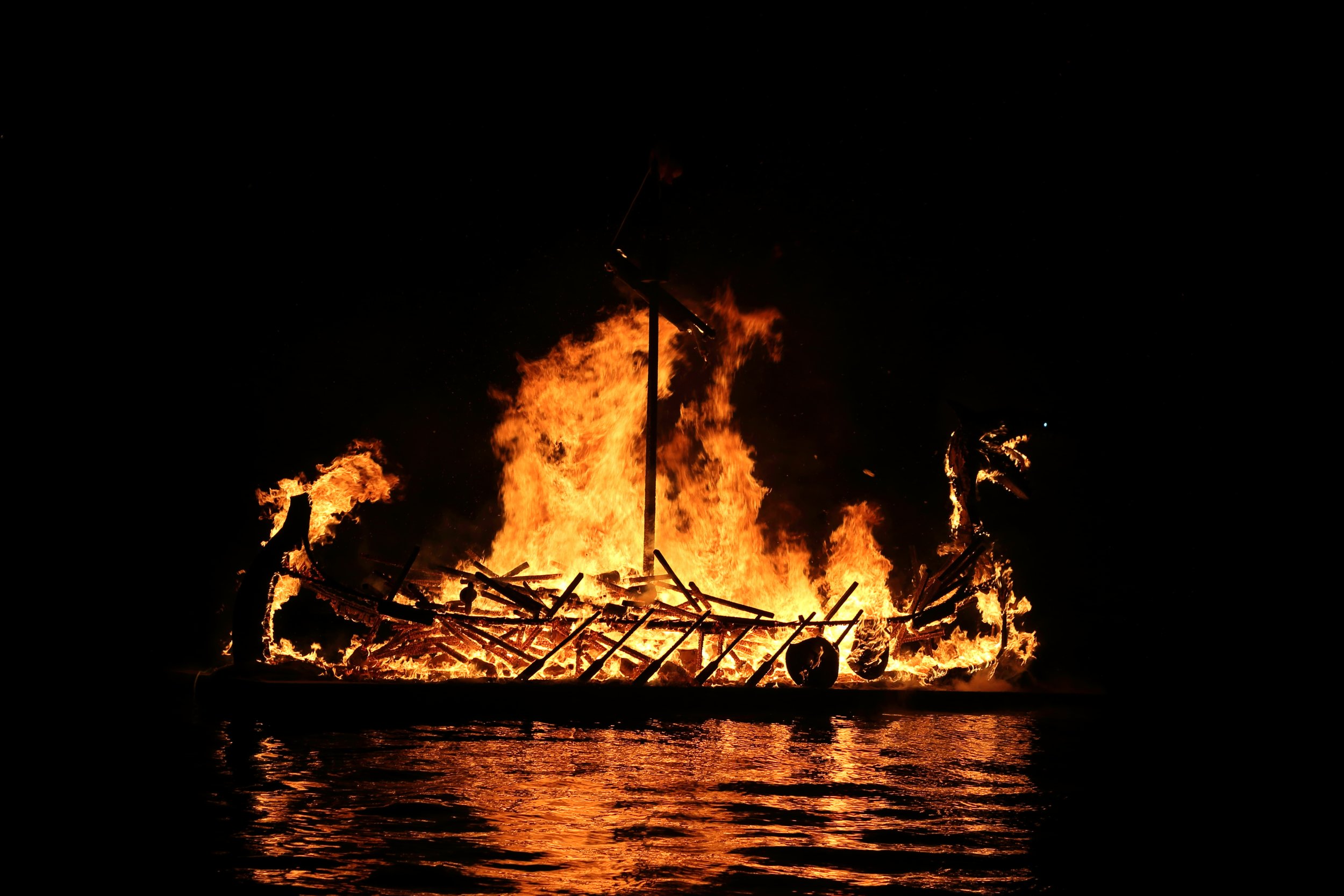The origins of Up Helly Aa and the festival today
Up Helly Aa burning, 2023
Up Helly Aa is almost upon us, and you can feel the town’s excitement growing as people prepare for what is, to some, the social event of the year. Despite what is often believed, Up Helly Aa is not an ancient festival passed down from Norse times but rooted in Shetland’s Victorian era. And like any proper Victorian soiree, theatrical pomp and ceremony were allowed to shine unbridled.
Up Helly Aa’s roots can be found in the 19th-century tradition of ‘tar-barrelling’, a practice which saw the town’s young men rolling burning barrels of tar through the narrow streets of Lerwick. This was banned in 1874 as it was dangerous and caused damage to local properties and humiliated the law-enforcers who were often tricked by the rowdy youths and locked into an endless game of ‘cat-and-mouse’. It has been argued that following the Napoleonic Wars, the men returning had developed a taste for firearms and so began the tradition. In the past, Shetland followed the Julian calendar long after the rest of the world adopted the Gregorian calendar. Christmas was held on the 5th January, New Year on the 12th and Up Helly Aa (or Uphellia) was held 24 days after Aald Yule, on the 29th January. However, the act of tar-barrelling might occur on any of these occasions.
In 1824 a visiting Methodist missionary described the scenes he found in Lerwick at Christmas:
The whole town was in an uproar from 12 o’clock last night until late this night blowing of horns, beating of drums, tinkling of old tin kettles, firing of guns, shouting, bawling, fiddling, fifeing, drinking, fighting. This was the state of the town all night – the street was thronged with people, as any fair I ever saw in England.
This lawlessness was a real problem for law-enforcers and town governors. The taste for fiery uproar and defiance of the law seemed insatiable and, in 1874, with mounting concerns for safety, tar-barrelling was banned, and 1876 saw the first organised procession. This procession, and those that would follow and become the festival as we know it today, was held in a bid to satisfy the desire for festivities.
Today Up Helly Aa is the biggest organised festival of the year, involving a dedicated team of committee members who ensure that the festival runs smoothly and safely. The festivities last for 24 hours on the last Tuesday of January. It is a Viking inspired fire festival that attracts thousands of visitors every year. A torchlit procession, led by the Guizer Jarl (chief Viking) weaves its way around the streets of Lerwick with over 1,000 torch-bearers carrying burning torches. After the procession, the guizers (as participants are known) heave their burning torches into a replica Viking longship and sing the Norseman’s Home. The atmosphere during the procession is electric as the street lights are extinguished, and visitors throng the streets, jostling for the best view, and the town glows under the light of the burning torches. The smell of paraffin and smoke permeate everything, and the rousing cheers echo around the buildings into the night sky.
Lerwick's King Harald Street houses lit up from the glow of the torches during the 2019 procession
After the ceremonial burning, a night of celebration commences as around a dozen public halls open up their doors to welcome the squads (or groups) of guizers to perform a sketch or a dance. These are private, ticketed parties and those attending must get an invite from one of the venue’s hosts or hostesses who organise the after-party. (Visitors can often pick up tickets from the Tourist Office.) A dedicated group of volunteers are responsible for organising and hosting these parties, and they don’t disappoint, laying on impressive spreads of soup, sandwiches, home bakes and ensuring that everyone is sufficiently fed and watered in order to keep on dancing right into the next day. During these 24 hours, the rule of the town is handed over by the police to the Guizer Jarl, and the Town Hall proudly flies the Raven Banner flag for the duration. For many, Up Helly Aa is the highlight of Shetland’s social calendar, and it is no surprise that the day after Up Helly Aa is a public holiday.
The 2019 Bill, the Up Helly Aa bill is displayed at the Market Cross every year on Up Helly Aa day and usually pokes fun at local events throughout the year. The first Bill was introduced to Up Helly Aa proceedings in 1899
Members of the 2019 Jarl Squad march along Commercial Street during the morning procession. This is a great chance to see the Jarl Squad's suits for the first time (in daylight!)
January, as anyone who has visited Shetland at this time will know, is punctuated by violent winter storms, driving wind and rain. However, as the organisers boast, “there will be no postponement for weather”, the show must go on. So, come rain or shine, the guisers take to the streets and perform the ritual. In its time, Up Helly Aa has only been cancelled a handful of times: Once for the death of Queen Victoria (1901) and the First and Second World Wars — and in more recent years, during the covid pandemic. It has also been postponed three times: Once due to an outbreak of flu and for the deaths of King George V (1936) and ex-Prime Minister Winston Churchill (1965).
A January day in Shetland (2019)
Liam Summers, 2020 Jarl, gave me a chance to try out a torch! These are heavier than they look (my arm did ache). Photo: Alexa Fitzgibbon
Up Helly Aa is also a celebration of the return of the light after a long, dark winter, it marks a turning point in the length of the days after the dark days of winter. By Up Helly Aa, there is a marked difference in the length of the days, and by 5 pm there is still a little light in the sky. After Up Helly Aa the days seem to lengthen more quickly – a welcome sight for Shetlanders in need of spring! But ultimately it’s a celebration of our Viking roots that I discussed in my last blog post that you can read here. The name can be traced back to Uphalliday, a pagan Norse mid-winter celebration.
In 2023, after lengthy discussions, women were permitted to be allowed to take part in the procession and squads at the Lerwick Up Helly Aa — traditionally, it was only men who took part, and women were responsible for the after parties in the halls.
The rural Up Helly Aa and Fire Festivals, of which there are 11 between January and March throughout Shetland, have historically allowed women to take part and have even seen female Guiser Jarls leading the proceedings.
SMUHA Up Helly Aa squad 2019
Lerwick is not the only festival, throughout Shetland between January and March, there are at 12 Fire Festivals that take place, with processions of Vikings and the burning of a replica longship. A full list can be found here.
You can watch a live stream of Up Helly Aa online, and if you follow my Instagram, I will keep you up to date with plans for the live broadcast.
2020 Jarl, Liam Summers. Three cheers for the Guizer Jarl! Photo: Alexa Fitzgibbon
In the meantime I'd like to wish this year’s Jarl all the best for his big day and I hope that all the squads and guizers have a brilliant day. Three cheers for the Guizer Jarl!
With love,














